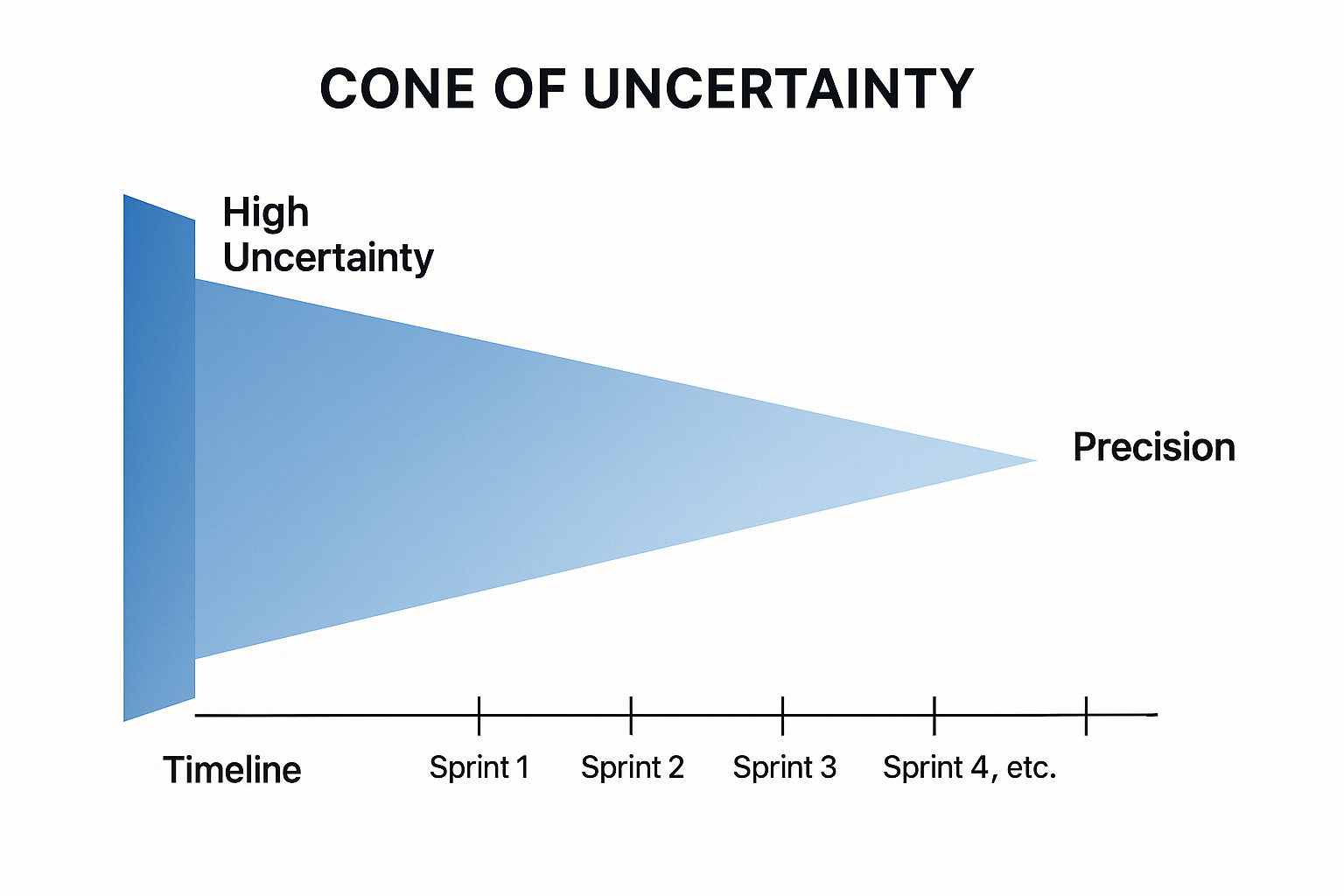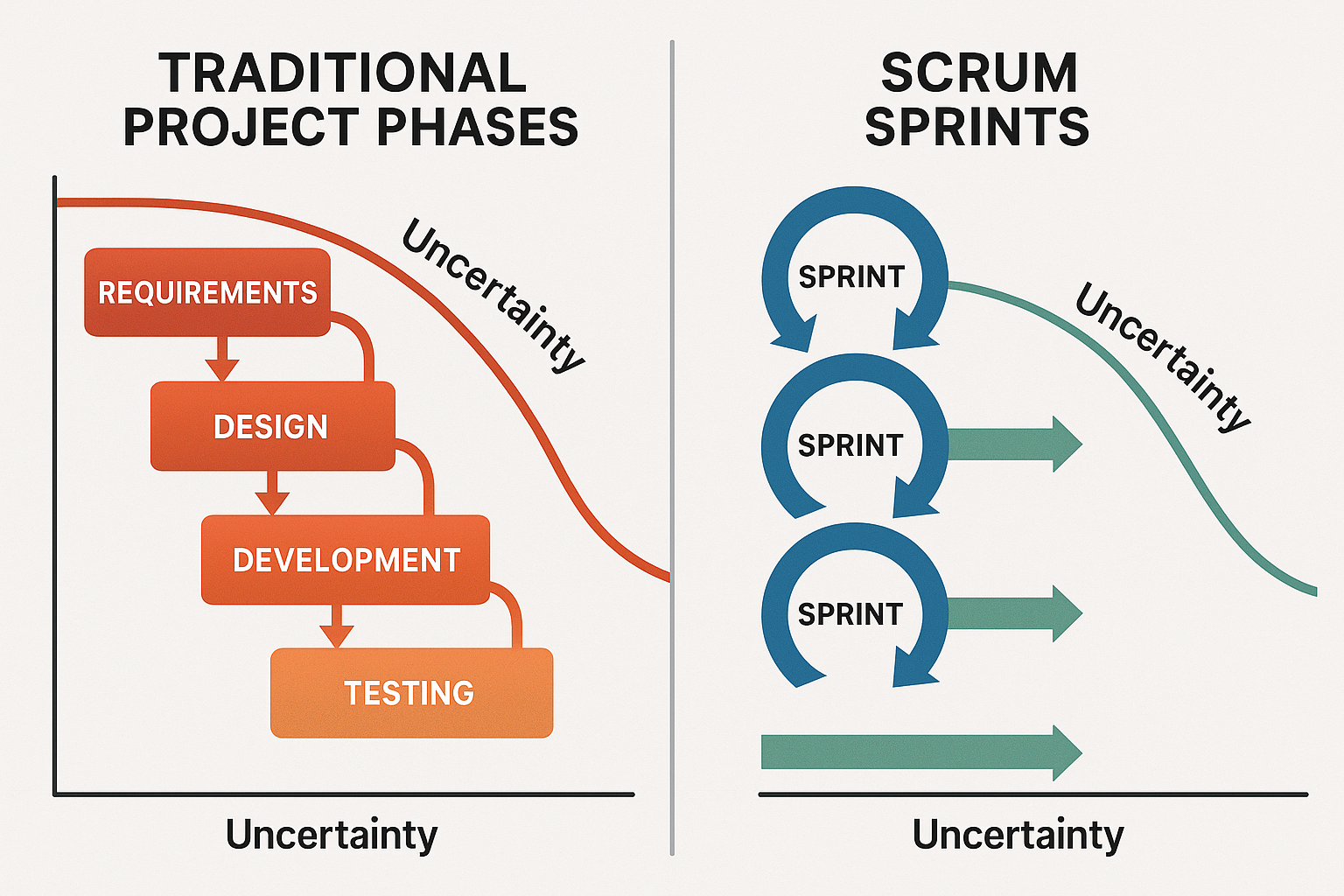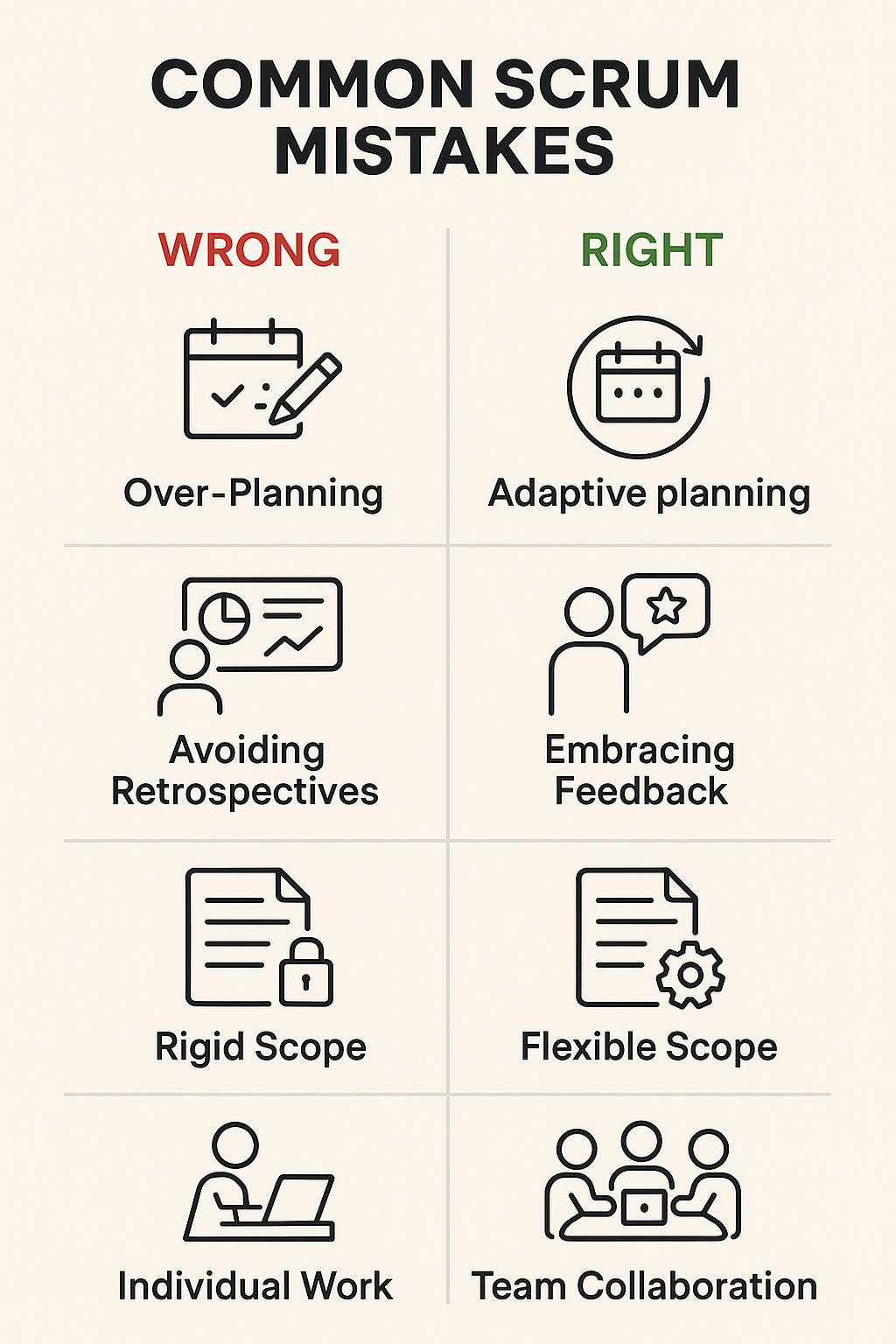Understanding the Cone of Uncertainty in Scrum Teams
Your stakeholders want to know when the project will be done. Your product owner needs to plan the next release. Your team is struggling with estimates that seem to change every sprint. If this sounds familiar, you’re dealing with one of the most fundamental challenges in agile development: uncertainty.
The cone of uncertainty isn’t just a theoretical concept—it’s a practical tool that can transform how your scrum team approaches estimation, planning, and stakeholder communication. When you understand how uncertainty naturally decreases over time, you can set better expectations, make more accurate forecasts, and avoid the estimation traps that derail so many agile projects.
Most teams try to fight uncertainty by demanding more precise estimates upfront. But the cone of uncertainty teaches us something different: embrace the uncertainty early, then systematically reduce it through empirical evidence. This shift in mindset can revolutionize how your team works and how stakeholders perceive your delivery capabilities.

What the Cone of Uncertainty Really Means
The cone of uncertainty describes how the accuracy of project estimates improves as work progresses and more information becomes available. At the beginning of any project, estimates can be wildly inaccurate—sometimes off by 400% or more. But as teams complete work and gather evidence, their ability to predict future outcomes becomes increasingly precise.
Think of it like planning a road trip to a destination you’ve never visited. At the start, you might estimate it will take 6 hours, but you could be off by several hours depending on traffic, weather, or route changes. After driving for 2 hours and covering a third of the distance, your estimate for the remaining time becomes much more accurate because you have real data about driving conditions, your actual speed, and any obstacles you’re encountering.
In software development, this uncertainty exists because we’re often building something that has never been built before. Requirements evolve as stakeholders see working software. Technical challenges emerge that weren’t anticipated during planning. Team dynamics and capabilities become clearer as people work together. All of these factors contribute to the natural uncertainty that exists at the beginning of any complex project.
The cone of uncertainty was originally developed for traditional project management, where it was tied to project phases like requirements gathering, design, and implementation. But this phase-based approach had a fundamental flaw: it assumed that completing a phase eliminated uncertainty from that area, which rarely happens in practice.
How Scrum Transforms the Cone of Uncertainty
Scrum takes a fundamentally different approach to managing uncertainty. Instead of trying to eliminate uncertainty through extensive upfront planning, scrum embraces uncertainty and uses empirical evidence to reduce it incrementally. This approach aligns perfectly with how uncertainty naturally behaves in complex work.
In scrum, uncertainty reduction happens through completed increments of working software, not through documentation or planning artifacts. Every sprint produces tangible evidence of what the team can actually deliver, how long work really takes, and what challenges exist in the problem domain. This evidence becomes the foundation for increasingly accurate forecasts.
The key difference is that scrum doesn’t assume uncertainty is eliminated—it assumes uncertainty is reduced through inspection and adaptation. When a team completes their first sprint and delivers 8 story points instead of the planned 15, that’s not a failure of estimation. It’s valuable data that helps the team understand their actual capacity and the real complexity of the work.
Empiricism in Action
Scrum’s empirical approach means that every sprint provides new data points that help narrow the cone of uncertainty. This happens through three key mechanisms: transparency, inspection, and adaptation. Teams make their work visible, regularly examine their progress and processes, and adjust their approach based on what they learn.
Consider a team that estimates they can complete 100 story points over 10 sprints, averaging 10 points per sprint. After the first sprint, they complete only 6 points. Traditional project management might see this as a 40% failure. Scrum sees it as valuable learning that helps the team make better predictions going forward.
With this new data, the team can update their forecast. If they maintain a 6-point velocity, the 100 points of work will take approximately 17 sprints instead of 10. This might not be the news stakeholders want to hear, but it’s more accurate than the original estimate and becomes the basis for better planning decisions.

Practical Application in Sprint Planning
Understanding the cone of uncertainty changes how effective teams approach sprint planning and release forecasting. Instead of treating estimates as commitments, teams treat them as hypotheses to be tested through actual delivery.
During sprint planning, teams acknowledge that their estimates are based on current understanding, which will inevitably change as work progresses. They plan for this uncertainty by building in buffers, focusing on the most important work first, and maintaining flexibility in scope and timeline.
Smart teams also use the cone of uncertainty to set stakeholder expectations appropriately. Early in a project, they communicate ranges rather than specific dates. “We estimate this feature will be ready sometime between sprint 8 and sprint 12” is more honest and ultimately more helpful than “We’ll deliver this in sprint 10” when the uncertainty is still high.
Velocity and Uncertainty Reduction
Team velocity is one of the most practical applications of cone of uncertainty principles in scrum. Velocity represents the team’s demonstrated capacity to deliver working software, and it becomes more predictable as the team completes more sprints. A team’s velocity in their first sprint might be 8 story points. In their second sprint, it might be 12 points. By the third sprint, it could be 10 points. At this point, stakeholders might be frustrated by the variability, but the team is actually gathering valuable data about their true capacity.
After 6-8 sprints, patterns typically emerge. The team might consistently deliver between 9-13 story points per sprint, with an average of 11. This range becomes the basis for more accurate forecasting. Instead of promising specific delivery dates, the team can provide probability ranges: “There’s a 70% chance we’ll complete this epic in 8 sprints, and a 90% chance we’ll complete it in 10 sprints.”
This approach to velocity and forecasting helps teams avoid the trap of false precision that plagues many agile implementations. Rather than pretending they can predict exactly what will happen, teams acknowledge uncertainty while systematically working to reduce it.
Managing Stakeholder Expectations
One of the biggest challenges teams face is helping stakeholders understand and accept uncertainty. Many business leaders are accustomed to traditional project management approaches that promise specific dates and deliverables, even when those promises are based on incomplete information.
The cone of uncertainty provides a framework for having more honest conversations about project timelines and scope. Instead of providing false certainty, teams can explain why estimates become more accurate over time and how stakeholders can help reduce uncertainty more quickly.
Effective scrum masters use the cone of uncertainty to educate stakeholders about the nature of complex work. They explain that demanding precise estimates early in a project actually increases risk because it encourages teams to pad their estimates or make commitments they can’t keep.
Communication Strategies
When communicating with stakeholders about uncertainty, focus on what you do know rather than what you don’t know. “Based on our first three sprints, we’re averaging 10 story points per sprint. The remaining work is estimated at 80 story points, so we expect completion in 6-10 sprints” is more helpful than “We don’t know when this will be done.”
Regular updates that show how uncertainty is decreasing over time help build stakeholder confidence in the process. Share velocity trends, show how estimates are becoming more accurate, and celebrate the learning that comes from each sprint. This transparency helps stakeholders understand that uncertainty reduction is a natural and valuable part of the development process.
Teams should also involve stakeholders in decisions about how to respond to new information. When a sprint reveals that work is more complex than expected, present options: “We can reduce scope to meet the original timeline, extend the timeline to deliver the full scope, or add resources to accelerate delivery.” This collaborative approach helps stakeholders feel involved in managing uncertainty rather than victims of it.
Common Mistakes and How to Avoid Them
Many teams struggle with the cone of uncertainty because they misunderstand its implications or try to apply it incorrectly. Understanding these common pitfalls can help your team use this concept more effectively.
Treating Estimates as Commitments
The biggest mistake teams make is treating early estimates as firm commitments. When stakeholders ask “When will this be done?” and teams respond with specific dates based on limited information, they’re setting themselves up for failure. The cone of uncertainty teaches us that early estimates are inherently imprecise, and treating them as commitments creates unrealistic expectations.
Instead, teams should communicate estimates as ranges that reflect the current level of uncertainty. “Based on what we know today, this work will likely take 8-15 sprints” is more honest than “This will be done in 10 sprints.” As uncertainty decreases, these ranges can become more precise.
Ignoring the Learning
Some teams track velocity and other metrics but fail to use this information to improve their forecasting. They continue making the same estimation mistakes sprint after sprint without learning from their experience. The cone of uncertainty only works if teams actively use new information to refine their predictions.
Effective teams regularly review their estimation accuracy and look for patterns in their misses. Are they consistently underestimating certain types of work? Do estimates become less accurate when working in unfamiliar technology areas? This analysis helps teams improve their estimation skills and reduce uncertainty more quickly.
Demanding False Precision
Organizations sometimes respond to uncertainty by demanding more detailed estimates or more frequent updates. This approach typically backfires because it encourages teams to spend time on estimation activities that don’t actually reduce uncertainty. The cone of uncertainty teaches us that precision comes from completing work, not from more detailed planning.
Teams should resist pressure to provide false precision and instead focus on delivering working software that provides real evidence about project progress. Regular demonstrations of working features do more to reduce uncertainty than any amount of detailed estimation.

Tools and Techniques for Uncertainty Management
Several practical tools and techniques can help teams apply cone of uncertainty principles more effectively in their scrum practice. These approaches focus on gathering better data, communicating uncertainty clearly, and making decisions that account for the natural variability in complex work.
Probabilistic Forecasting
Instead of providing single-point estimates, teams can use probabilistic forecasting to communicate ranges of possible outcomes. Tools like Monte Carlo simulations can help teams understand the likelihood of different completion dates based on their historical velocity data.
For example, a team might determine that there’s a 50% chance they’ll complete an epic in 8 sprints, a 70% chance they’ll complete it in 10 sprints, and a 90% chance they’ll complete it in 12 sprints. This information helps stakeholders make better decisions about scope, timeline, and resource allocation.
Rolling Wave Planning
Rolling wave planning involves detailed planning for near-term work while keeping longer-term plans at a higher level. This approach acknowledges that uncertainty makes detailed long-term planning ineffective while ensuring that teams have enough detail to work effectively in the short term.
Teams might plan the next 2-3 sprints in detail while maintaining only high-level estimates for work that’s 6+ sprints away. As work progresses and uncertainty decreases, they can add more detail to future sprints. This approach balances the need for planning with the reality of uncertainty.
The Business Value of Embracing Uncertainty
Organizations that learn to work effectively with uncertainty gain significant competitive advantages. They can respond more quickly to market changes, make better investment decisions, and avoid the waste that comes from over-planning in uncertain environments.
When teams embrace the cone of uncertainty, they become more honest about what they can deliver and when. This honesty might be uncomfortable initially, but it leads to better decision-making and more realistic expectations. Stakeholders can make informed trade-offs between scope, timeline, and quality instead of operating under false assumptions.
Teams that understand uncertainty also become more adaptable. They’re prepared for estimates to change as new information emerges, and they have processes in place to respond effectively to these changes. This adaptability is crucial in today’s fast-changing business environment.
The cone of uncertainty also helps organizations avoid the sunk cost fallacy. When teams regularly reassess their progress and update their forecasts, it becomes easier to make rational decisions about whether to continue, pivot, or stop projects that aren’t delivering expected value.
Building Uncertainty Awareness in Your Team
Developing a healthy relationship with uncertainty requires both mindset shifts and practical skill development. Teams need to learn new ways of thinking about estimates and planning while also developing the technical skills to work effectively in uncertain environments.
Start by helping team members understand that uncertainty is natural and valuable, not a sign of poor planning or execution. Share examples of how uncertainty reduction has helped other teams make better decisions and deliver more value. Create an environment where people feel safe acknowledging what they don’t know rather than pretending to have certainty they don’t possess.
Practice estimation techniques that account for uncertainty, such as three-point estimation or planning poker with confidence intervals. Regularly review estimation accuracy and discuss what the team is learning about their work and their capabilities. Celebrate instances where changing estimates led to better outcomes rather than treating estimate changes as failures.
Most importantly, focus on building the team’s ability to gather and respond to feedback quickly. The faster teams can learn from their work, the more quickly they can reduce uncertainty and improve their forecasting accuracy. This might involve improving development practices, enhancing collaboration with stakeholders, or investing in better tools and automation.
Ready to master the skills needed to work effectively with uncertainty? Certified ScrumMaster training provides the foundation for understanding how scrum’s empirical approach reduces uncertainty over time. For product owners who need to communicate with stakeholders about uncertain timelines, Certified Scrum Product Owner certification offers practical techniques for managing expectations and making decisions under uncertainty.
Teams looking to implement these practices systematically can benefit from professional agile coaching that helps organizations build cultures that embrace uncertainty as a source of learning rather than a problem to be eliminated. For organizations ready to transform how they approach planning and forecasting, agile consulting services can provide the guidance and support needed to implement uncertainty-aware practices across multiple teams and projects.
Questions? We Can Help.
When you’re ready to move beyond piecemeal resources and take your Agile skills or transformation efforts to the next level, get personalized support from the world’s leaders in agility.